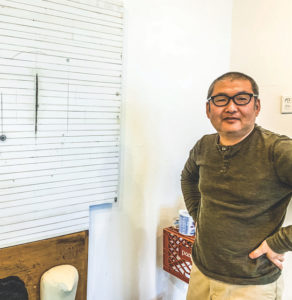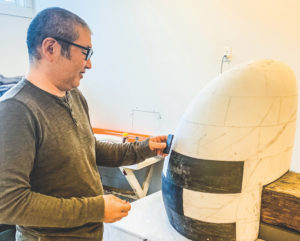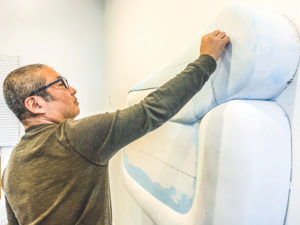
Hiroyuki Hamada arrived in Provincetown on March 1 to spend the month as a mid-career artist-in-residence at the Fine Arts Work Center. Now, though FAWC is closed to the public because of the COVID-19 pandemic, and an artist talk and open studio that had been scheduled for Hamada were both canceled, he continues to work in his studio at the work center. Before the crisis limited social interactions on the Outer Cape, he sat down with the Independent to offer some insights on his art and how it interacts with the world.
Hamada, who lives and works in East Hampton, N.Y., has a long history with Provincetown. He was a FAWC fellow in 1995-96, and the time he spent at the work center was, he says, a great privilege and a turning point in his career. He has since been the recipient of numerous awards and residencies, including a Pollock-Krasner Foundation grant in 1998 and a Guggenheim Fellowship in 2018. Being back in Provincetown has been an opportunity for Hamada to reflect on his evolution as an artist. He is a soft-spoken man, who chooses his words with care.
“Because this is a place where I used to be, I’m thinking about how things were,” he says. “It’s very interesting. I was very idealistic as a young artist. I believed in the power of art — that we can all speak the same language, that art can connect people, transcend differences. I learned, however, that there is a definite hierarchy in our society that we can’t ignore. And that all the good things about art can also be used as a justification for the social framework we have in place.” That framework gives him pause.

“This is the structural difficulty for the artist within our society,” Hamada says. “As artists, we make art and work with institutions thinking that we are doing good, that we are working for the people. But if we look at the institutions that are part of our social framework, they have the tendency to uphold the ruling class. It’s a difficult situation, and I don’t really have the answers.”
While he feels that art should be “something that is more than money and power,” Hamada insists that when art is used as a tool toward an end, it loses something. “Art can affect people in some ways, but it’s not going to cause social change,” he says. “There is something very human about art, something very fragile. If we try to use art for a particular means, and if that notion comes across, the quality is muddied.”
Instead, Hamada believes that what an artist can offer society is both deeper and less easily defined. “When I’m in the studio, I listen to what I am doing and pay attention to everything that is going on,” he says. “I try to express something that is cohesive, strong, and profound on its own.”

His creative process is intuitive, but he has gained experience over the years. “I have learned the skill of connecting dots when I see things,” he says. “We can’t ignore certain things in the studio in favor of others. In a painting, for example, you want colors to speak, shapes to speak. Everything has to work together — nothing can be left out or wasted. One force is met with other forces, and all these things have to be taken into consideration at once. That kind of approach has allowed me to see life in a different way. You can’t just change something and expect everything else to stay the same: if you make one change, everything becomes different.”
Hamada came to the U.S. from Japan reluctantly at age 18 — his family moved here because of a job his father was offered — and he studied painting in college, getting an M.F.A. from the University of Maryland. He began to work in sculpture for the first time as a fellow at FAWC, 25 years ago.
“I became interested in sculptural qualities, in objectness and textures, as opposed to creating a painting to look into, with visual narratives and themes,” he says. “So, my paintings grew out of the wall and became three-dimensional.”
Hamada’s sculptures, which he purposefully never titles so as not to limit the viewer’s interpretation, often emerge around found objects that, he says, “begin to speak” to him. A sculpture-in-progress in his studio, for example, contains an object he found on the beach, an object that was lying in his studio, and a piece of recycled wood. In addition to found objects, Hamada creates with construction materials — wood, foam, joint compound, and resin. “I have come up with my own way of working with my materials,” he says.
Despite his focus on sculpture, Hamada has continued to draw and paint throughout his career. And while he has been in Provincetown, he has watched his work evolve in unexpected directions. “I’m curious to see what this one is going to be,” he says of one piece. “I think it is coming back to two-dimensionality. It’s a relief. If you look at it from the side, it’s definitely distorted. If I like how this one turns out, I might welcome more pieces like this.”



